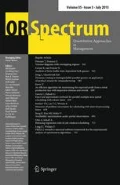Abstract
We consider a production/inventory system consisting of one production line and multiple products. Finished goods are kept in stock to serve stochastic demand. Demand is fulfilled immediately if there is an item of the requested product in stock and otherwise it is backordered and fulfilled later. The production line is modeled as a non-preemptive single server and the objective is to minimize the sum of the average inventory holding costs and backordering costs. We investigate the structure of the optimal production policy, propose a new scheduling policy, and develop a method for calculating base stock levels under an arbitrary but given scheduling policy. The performance of the various production policies is evaluated in extensive numerical experiments.


Similar content being viewed by others
References
Adan I, Sleptchenko A, Van Houtum G (2009) Reducing costs of spare parts supply systems via static priorities. Asia-Pacific J Oper Res 26(04):559–585
Arreola-Risa A, Giménez-García V, Martínez-Parra J (2011) Optimizing stochastic production-inventory systems: a heuristic based on simulation and regression analysis. Eur J Oper Res 213(1):107–118
Bertsekas D (2007) Dynamic programming and optimal control, 3rd edn, vol. II. Athena Scientific, USA
De Vericourt F, Karaesmen F, Dallery Y (2000) Dynamic scheduling in a make-to-stock system: a partial characterization of optimal policies. Oper Res 48(5):811–819
DeCroix G, Arreola-Risa A (1998) Optimal production and inventory policy for multiple products under resource constraints. Manag Sci 44(7):950–961
Dusonchet F (2003) Dynamic scheduling for production systems operating in a random environment. PhD thesis, École Polytechnique Fédérale de Lausanne
Gavish B, Graves S (1980) A one-product production/inventory problem under continuous review policy. Oper Res 28(5):1228–1236
Ha A (1997) Optimal dynamic scheduling policy for a make-to-stock production system. Oper Res 45(1):42–53
Janakiraman G, Nagarajan M, Veeraraghavan S (2009) Simple policies for managing flexible capacity. Working paper
Janssen R, Blankers I, Moolenburgh E, Posthumus B (2014) The impact of 3-d printing on supply chain management. Tech. rep, TNO
Kat B, Avşar Z (2011) Using aggregate fill rate for dynamic scheduling of multi-class systems. Ann Oper Res 182(1):87–117
Khajavi S, Partanen J, Hölmstrom J (2014) Additive manufacturing in the spare parts supply chain. Comput Ind 65(1):50–63
Li L (1992) The role of inventory in delivery-time competition. Manag Sci 38(2):182–197
Liang W, Balcıoğlu B, Svaluto R (2013) Scheduling policies for a repair shop problem. Ann Oper Res 211(1):273–288
Lieckens KT, Colen PJ, Lambrecht MR (2013) Optimization of a stochastic remanufacturing network with an exchange option. Dec Supp Syst 54(4):1548–1557
Linebaugh K (2008) Honda’s flexible plants provide edge. Wall Street J 22:B1
Liu P, Huang SH, Mokasdar A, Zhou H, Hou L (2014) The impact of additive manufacturing in the aircraft spare parts supply chain: supply chain operation reference (scor) model based analysis. Prod Plann Control 25(13–14):1169–1181
Niño-Mora J (2007) Dynamic priority allocation via restless bandit marginal productivity indices. Top 15(2):161–198
Peña Perez A, Zipkin P (1997) Dynamic scheduling rules for a multiproduct make-to-stock queue. Oper Res 45(6):919–930
Porteus EL (2002) Foundations of stochastic inventory theory. Stanford University Press, Palo Alto
Sanajian N, Abouee-Mehrizi H, Balcıoğlu B (2010) Scheduling policies in the M/G/1 make-to-stock queue. J Oper Res Soc 61(1):115–123
Sobel M (1982) The optimality of full service policies. Oper Res 30(4):636–649
Steiger N, Wilson J (2001) Convergence properties of the batch means method for simulation output analysis. INFORMS J Comput 13(4):277–293
Van Houtum G, Adan I, Van der Wal J (1997) The symmetric longest queue system. Stoch Models 13(1):105–120
Veatch M, Wein L (1996) Scheduling a make-to-stock queue: index policies and hedging points. Oper Res 44(4):634–647
Wein L (1992) Dynamic scheduling of a multiclass make-to-stock queue. Oper Res 40(4):724–735
Whittle P (1988) Restless bandits: activity allocation in a changing world. J Appl Probab 25:287–298
Zheng Y, Zipkin P (1990) A queueing model to analyze the value of centralized inventory information. Oper Res 38(2):296–307
Zipkin P (1995) Performance analysis of a multi-item production-inventory system under alternative policies. Manag Sci 41(4):690–703
Acknowledgments
We kindly thank the associate editor and two anonymous referees for their helpful suggestions to improve the paper.
Author information
Authors and Affiliations
Corresponding author
Calculation of E(P|w)
Calculation of E(P|w)
Let P represent an exponentially distributed time variable with mean \( 1/\mu \). Consider a queuing system where customers arrive according to a Poisson distribution with constant rate \( \lambda \). In this appendix, we show that E(P|w) , the expectation of a time interval given that during this time interval w customer arrivals occur, is equal to \( (w+1)/(\lambda + \mu ) \). Using the definition of conditional expectation and the property that the number of Poisson arrivals during an exponentially distributed time interval with mean \( 1/\mu \) has a geometric distribution with success probability \( \frac{1}{1 + \frac{\lambda }{\mu }} \), we obtain the following expression for E(P|w) :
Rearranging terms, and using that \( \frac{(\lambda + \mu )^{w+2} \quad t^{w+1}}{(w+1)!} \quad \mathrm {e}^{-(\lambda + \mu ) \, t} \) is the probability density function of the Erlang distribution with parameters \( (w + 2) \) and \( (\lambda + \mu ) \), we can rewrite expression (13a) as follows:
Finally, we obtain the desired result \( E(P|w) = (w+1)/(\lambda + \mu ) \) from (13c) via straightforward algebraic manipulations.
Rights and permissions
About this article
Cite this article
Tiemessen, H.G.H., Fleischmann, M. & van Houtum, G.J. Dynamic control in multi-item production/inventory systems. OR Spectrum 39, 165–191 (2017). https://doi.org/10.1007/s00291-016-0448-9
Received:
Accepted:
Published:
Issue Date:
DOI: https://doi.org/10.1007/s00291-016-0448-9




